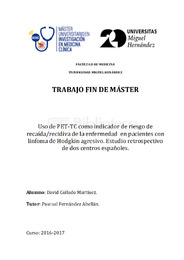Por favor, use este identificador para citar o enlazar este ítem:
https://hdl.handle.net/11000/27462Registro completo de metadatos
| Campo DC | Valor | Lengua/Idioma |
|---|---|---|
| dc.contributor.advisor | Fernández Abellán, Pascual | - |
| dc.contributor.author | Collado Martínez, David | - |
| dc.contributor.other | Departamentos de la UMH::Medicina Clínica | es_ES |
| dc.date.accessioned | 2022-06-22T16:51:52Z | - |
| dc.date.available | 2022-06-22T16:51:52Z | - |
| dc.date.created | 2017-09-09 | - |
| dc.identifier.uri | https://hdl.handle.net/11000/27462 | - |
| dc.description.abstract | El linfoma de Hodgkin (LH) es una enfermedad curable que afecta a individuos jóvenes. Antiguamente se aplicaba un mismo tratamiento tóxico a todos los pacientes pero ahora se individualiza en función de sus características. Al igual que mejoran los tratamientos también lo hacen las técnicas para detectar pacientes de alto o bajo riesgo y así individualizar aún más el tratamiento. El diagnóstico por imagen se quiere convertir en una herramienta fundamental para el detectar pacientes de alto riesgo. Se utiliza la tomografía computerizada (TC) pero presenta muchos falsos negativos en enfermedad de bajo volumen. Una alternativa importante es la tomografía por emisión de positrones (PET-TC). En nuestra investigación queremos saber si el PET-TC puede determinar el estado de la enfermedad y si éste influye en la supervivencia libre de progresión (SLP). Un PET-TC negativo representa ausencia de enfermedad y positivo enfermedad activa. Hemos realizado un estudio de cohortes retrospectivas de dos centros con un tamaño muestral relevante. Tras los análisis estadísticos, los pacientes con PET-TC positivo antes del trasplante autólogo de precursores hematopoyéticos presentan una menor SLP que los pacientes con PET-TC negativo. Se relaciona el PET-TC positivo con una peor evolución de siendo éstos los pacientes de alto riesgo. Hodgkin Lymphoma (HL) affects young people but it can be cured. At the beginning they were treated with the same chemotherapy but it produced many side effects. Nowadays the treatment to HL is individualized. The new therapies are improving as well as the techniques to select the high or low risk patients. Diagnostic imaging is a very useful tool to expose high-risk patients. The Computed Tomography (CT) is used for the diagnose of HL. It can present false positive results. The PET-TC is currently the most commonly used technique for diagnosis In our study, we want to know if the PET-CT is usefull to evaluate the HL and if its results are associated with progression free survival (PFS). We considered that PET-CT negative links a patient without HL and a PET-CT positive links an active disease. Our investigation project consists of a retrospective cohort study that includes patients from two hospitals. Analycing our results we can say that patients with a positive PETCT before the autologous stem cell transplantation has worse PFS than patients with a negative PET- CT. As conclusion, a positive PET-CT is related to a worse evolution of the disease and could be considered as high-risk individuals. | es_ES |
| dc.format | application/pdf | es_ES |
| dc.format.extent | 42 p. | es_ES |
| dc.language.iso | spa | es_ES |
| dc.publisher | Universidad Miguel Hernández | es_ES |
| dc.rights | info:eu-repo/semantics/openAccess | es_ES |
| dc.rights | Attribution-NonCommercial-NoDerivatives 4.0 Internacional | * |
| dc.rights.uri | http://creativecommons.org/licenses/by-nc-nd/4.0/ | * |
| dc.subject | Linfoma de Hodgkin | es_ES |
| dc.subject | Recaída tumoral | es_ES |
| dc.subject | PET-TC | es_ES |
| dc.subject | Trasplante autólogo | es_ES |
| dc.subject.other | CDU::6 - Ciencias aplicadas::61 - Medicina::616 - Patología. Medicina clínica. Oncología | es_ES |
| dc.title | Uso de PET-‐TC como indicador de riesgo de recaída/recidiva de la enfermedad en pacientes con linfoma de Hodgkin agresivo. Estudio retrospectivo de dos centros españoles | es_ES |
| dc.type | info:eu-repo/semantics/masterThesis | es_ES |

Ver/Abrir:
collado_martinez,david.pdf
526,19 kB
Adobe PDF
Compartir:
 La licencia se describe como: Atribución-NonComercial-NoDerivada 4.0 Internacional.
La licencia se describe como: Atribución-NonComercial-NoDerivada 4.0 Internacional.
.png)